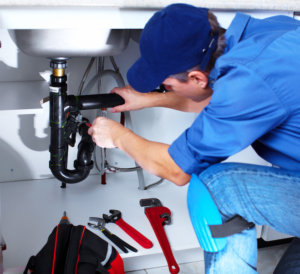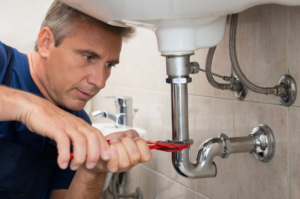Plumbing is a career that requires an unusually high level of physical strength and stamina. It’s also a highly regulated profession, with specific knowledge of local codes and regulations required.
Plumber Bucks County install and repair pipes that supply water and gas to, and carry waste away from, homes and businesses. This includes fixtures such as sinks, bathtubs, toilets, and showers. They also work with HVAC systems.

As part of their job, plumbers install plumbing systems for new construction or renovation projects. This involves laying pipes and installing fixtures such as sinks, toilets, dishwashers and water heaters. They also make sure that the location and design of the new system meets building codes and other regulations. During the installation process, plumbers often need to read blueprints and plan out the layout of the piping before beginning work.
Plumbers may also be called to repair existing plumbing systems. This can involve removing old fixtures and relocating or adding new ones, as well as fixing leaks and making other adjustments. Plumbers must be knowledgeable about a wide range of materials and tools in order to perform these tasks. They must also be able to troubleshoot problems with existing plumbing and recommend solutions.
Some plumbers are also responsible for installing gas lines. This is a dangerous job that requires knowledge of gas safety standards and proper installation techniques. Plumbers who specialize in this area usually have a specialty certification.
To become a plumber, you typically need at least a high school diploma or equivalent and completion of an apprenticeship program. Additional qualifications include strong customer service skills, since you’ll be working directly with clients to understand their needs and explain the work that needs to be done. You’ll also need a valid plumber’s license in your area, which you can obtain by passing a written exam and completing a practical exam. Requires candidates to have a minimum of two years of practical experience as a journeyman plumber, along with proof of liability insurance and a completed application form. You can find more information on the Department of Buildings website. The licensing period varies from place to place, so check with your local government for specifics. However, most plumbers need to renew their licenses every two to three years. This renewal process usually includes paying fees. Some states require license holders to take continuing education classes to maintain their licenses. This is important because it keeps plumbers up to date on the latest trends and best practices in their field.
Maintenance
Plumbing systems are complex, and ensuring that they’re functioning correctly is a top priority for plumbers. Maintenance tasks can include:
- Inspecting, repairing, or replacing pipes and fixtures.
- Testing water pressure levels.
- Installing new appliances like dishwashers, washing machines, and toilets.
- Rerouting existing plumbing to accommodate construction projects.
- Cleaning drains and sewer lines.
Plumbers also work on industrial plumbing systems, assessing and maintaining the pipes that carry water, steam, and chemicals in heating, cooling, and process piping.
Most plumbers learn the trade through an apprenticeship, which lasts four to five years and includes classroom instruction and paid on-the-job training. After completing their apprenticeship, plumbers must pass state licensing exams to become fully licensed. They must also participate in continuing education to stay current on technology, equipment, and regulations.
In residential settings, maintenance plumbers install pipes, toilets, faucets, and other fixtures; inspect and test existing plumbing to identify issues; and repair or replace damaged or worn-out parts. They also diagnose problems like clogged drains and leaky toilets, and they ensure that all plumbing codes are met for safety and efficiency.
Commercial plumbers focus on larger-scale plumbing systems in office buildings, restaurants, manufacturing plants, and other large spaces. These plumbers may specialize in a particular type of system, such as gas pipe installation or water heater maintenance. They also have broader knowledge of all types of plumbing systems and can troubleshoot more complicated issues.
A plumbing contractor’s job is to keep their customers happy by providing quality service and addressing any concerns promptly. This can be achieved by ensuring that all repairs are made accurately and efficiently, communicating clearly with clients about estimates and timelines, and being respectful of customers’ homes.
Another way that plumbing businesses can better serve their customers is by implementing a simple CMMS software solution. These digital solutions can help plumbers keep track of all tickets, inventory, and maintenance activities in one place, eliminating the need for paper documentation or spreadsheets. This allows plumbing companies to streamline their preventative maintenance processes, saving both time and money. Using a digital maintenance solution can also enable plumbers to easily access warranty information for parts and fixtures, allowing them to quickly address any issues.
Troubleshooting
One of the most important skills that plumbers must have is the ability to troubleshoot. This process involves finding out what caused a problem and then fixing it. It’s vital for ensuring that all plumbing systems function properly and safely. Effective troubleshooting can also save money by reducing the need for costly repairs and downtime.
Plumbers use a variety of tools and techniques to help them identify and solve problems quickly. For example, they may take note of any strange sounds coming from the plumbing system and then check for issues such as a clogged drain or water leaks. They can also use advanced equipment to inspect the inside of pipes and joints for damage or blockages.
Leaky pipes are one of the most common plumbing problems. If left unchecked, these leaks can cause serious water damage to wood and masonry and increase your water bill significantly. A plumber will be able to quickly and easily find the source of the leak and repair it before it causes more damage.
Another common plumbing issue is low water pressure. This can be due to a number of factors, including a broken pipe, a faulty valve, or a clogged drain. A plumber will be able to fix the problem and restore normal water pressure.
Finally, a plumber can also help with a sewer line backup. This is a dangerous and unpleasant problem that can send dirty, smelly sewage back into your home. A plumber will be able to clear the clog and restore proper functioning of your plumbing system.
Plumbers must have a wide range of skills to succeed in their careers. In addition to technical knowledge, they must be able to effectively communicate with customers and other stakeholders. This is especially important when working with residential and commercial clients, as they often have unique needs and concerns. In addition, plumbers must be able to work efficiently and accurately to complete their tasks on time and within budget. By combining technical expertise with problem-solving skills, plumbers can solve a variety of complex issues and improve the functionality of a system.
Repair
While some homeowners choose to do their plumbing repair work themselves, there are many instances where a professional plumber is necessary. These professionals possess in-depth knowledge of plumbing systems, materials and techniques, allowing them to diagnose and solve complex problems with ease. In addition, they are equipped with the proper tools to ensure that the job is done correctly and safely.
Common plumbing issues that require repairs include leaks, clogs and low water pressure. When a homeowner notices these or other issues, they should contact a plumber right away. Before the plumber arrives, they should turn off the water supply valve to the affected area. This will prevent any further damage to the pipes and fixtures. Then, the plumber can assess the situation and determine what steps to take to repair it.
Plumbers use a variety of tools and materials to fix various problems, including pipe cutters, wrenches, couplings and soldering equipment. They may also need to purchase parts such as fittings and replacement pipes. To ensure that the right size fixture is used, plumbers often measure the existing pipes before ordering the new ones. This helps them avoid any future problems due to mismatched or improperly fitted components.
Before beginning any repair, a plumber will carefully clean the area and clear any obstacles from the workspace. They will then use a camera to inspect the pipes for any signs of wear and tear or other damage. If they find any issues, the plumber will mark them on the surface using spray paint. This allows them to know where they should dig or cut to get to the damaged part of the pipe.
Once the plumber has assessed the situation, they will begin repairing the pipe. This can involve patching a small leak, installing a new water stop or replacing an entire section of the pipe. Plumbers will typically cut out the old section of the pipe, clean and dry the area, then install the new one using the appropriate methods. Once the plumber has finished, they will test the water flow to make sure everything is working as it should.

